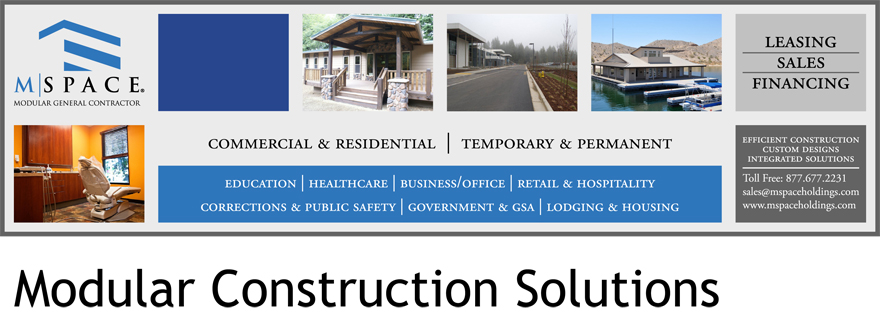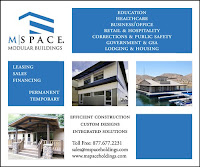While a new dorm or learning space might be needed or
desirable on campus, facing down the associated headaches of time, mess, and
expense can overshadow the benefits the finished project might bring.
Modular construction is an alternative delivery method that
can tame some of those issues. Unfortunately, the word modular sends people
back to the drafty trailers they remember from elementary school.
“Modular can be concrete and steel,” says Jim Snyder,
director of operations for Warrior Group Construction. “It doesn’t have to look
like an 8th-grade science class.”
“They aren’t the trailer park or doublewides that come to
mind when you think of modular,” agrees David Rabold, capital projects manager
at Muhlenberg College (Pa.), where multiple dorms have been constructed using
the off-site construction method.
“The myths of modular construction are from years ago when
it was all wooden boxes,” says Dan Harrigan, principal at Spillman Farmer
Architects. “They would warp and not line up.” His firm has worked on several
projects at Muhlenberg and other colleges.
When compared to traditional building methods, modular
construction, also known as off-site construction, prefabricated construction,
and pre-manufacturing, can save time, reduce disruption to campus, and even
save money. As construction projects return to campus with the economic
recovery, this method deserves a second look.
Time Is of the Essence
Old habits die hard. People aren’t comfortable with modular
construction, despite the potential efficiencies, because they aren’t familiar
with it, says John Dolan, a project executive with the construction firm
Skanska.
Permanent modular construction is a far cry from a temporary
modular building that can be hauled away when no longer needed, says Snyder. The
main difference between a modular building and a traditional “stick build”
structure is in method of construction. “In modular, up to 90 percent of the building is completed in
a factory and delivered to the site,” explains Glenn Cort, executive vice
president of Triumph Modular. This process compresses the project timeline
because all of the “major tasks happen simultaneously. While people are on site
doing work, the building is being constructed in a factory.”
When educating people about the advantages of modular,
experts usually start with the time advantage. Since the building elements are
constructed in a temperature-controlled factory and delivered complete to the
site, working around the weather is less of an issue with a modular project.
Time was a critical component when Muhlenberg leaders
decided in 2006 to replace an older dorm with new apartment-style housing,
remembers Rabold. “We took over the site in May 2007 and had the first RA
living in a building in August.”
The success and popularity of The Village gave campus
leaders the confidence to use modular for an addition on their 150-year-old
East Hall. While Rabold says it’s a “gorgeous” building with fireplaces in each
room and other amenities that would have been expected back in the day, it
doesn’t fulfill modern expectations. The addition of social spaces will reduce
available beds, which is in conflict with their housing policy and the fact
that 90 percent of students live on campus.
“We’re building an addition that will be modular. It will be
36 beds. The cost will be comparable to a new dorm, but we are saving time,” he
explains. The new building is expected to be ready for RAs and support staff to
move in the weekend of August 12.
“On June 1, we have to dig a hole and build the foundation
to be ready to receive the modules for June 12. About four days later, we’ll
have a building,” Rabold shares. The schedule for The Village was so precise;
they knew which day each of the 20 modules was being completed.
Time was also a factor when the University of Saint Francis
(Ind.) built new apartment-style housing in 2004. “We only had from when
students left in the summer to when they returned to campus,” recalls Tom
Buuck, director of operations. Padua Hall broke ground in February that year.
Minimize Disruption
With the majority of the construction with modular taking
place off-site, the delivery method means less disruption to campus than
traditional construction.
“What wows people about pre-manufactured is that you go from a blank slate to a finished project very quickly,” says Dolan. It also reduces the chances people will improvise to get the project done, which ensures consistent quality.
“What wows people about pre-manufactured is that you go from a blank slate to a finished project very quickly,” says Dolan. It also reduces the chances people will improvise to get the project done, which ensures consistent quality.
The boxes, as the individual elements are called, are
usually constructed on an assembly line, with cranes moving them down the line.
“People do the flooring, windows, plumbing. All the things you expect to see in
a permanent facility are built in a factory,” explains Snyder. “But you can
stack a box on top of a box, and as long as it was well thought out you can see
a space that is as open as a traditional building.” Then, at the job site, you
just need a crane to put all the boxes together.
Reducing disruptions was a concern with the renovations to
East Hall, Rabold says. “If we did it stick-build, on-site, we would have built
during the year. It’s in one of the open legs of a quad and would have
disrupted several hundred students year round. We would have had to put time
restrictions on the contractors, not during exams, etc. It wouldn’t have
worked.”
During the winter break, the groundwork for electric and
water was done. By the time students returned to campus, the holes were filled
so they never knew it happened, he says. The next round of activity won’t
happen until after graduation in May.
“Usually, projects go on for a year and the campus doesn’t
look good during tours,” points out Harrigan. “Modular usually has less of an
impact, maybe just two or three months.”
But just because arrangements can be made to avoid
disturbing students, don’t expect it to be mess-free. “You still have to build
a foundation. You still have to put on a roof and a wrap-around,” cautions Rex
Bercot, building superintendent at the University of Saint Francis. After the
boxes for Padua Hall were installed, a brick facing and balconies were added
on-site. “If you went by the building, you couldn’t tell it was a modular
building. I’d bet $100 that you couldn’t tell.”
However, the Padua Hall project resulted in less damage to
the earth when compared to a traditional project, Buuck says. “If you have
construction during the school year, you have to put up fences and make sure
students don’t go poking around. When the modular units came in, the doors were
already locked.”
Stylish and Green
Careful planning can result in spacious and gracious modular
buildings. “We can deliver large, complex buildings,” assures Cort.
Modular does have to be on the table at the very beginning
of the design process, because there are restrictions related to shipping a box
on the highways, says Harrigan. “You have to know how the units will be broken
down and where the meet lines will be.”
While minor adjustments were made to the proposed addition
to East Hall to accommodate the modular method, the end result meshes with the
existing 150-year-old structure, says Rabold. “We’re getting a tower to
complement the existing towers, there is an elevator, and we have roll-in
showers.”
“You hear that ceiling heights are an issue because they get a ceiling and
floor in one space, but the existing building has low ceilings and we’re within
inches of matching that,” he adds.
Students who initially signed up to live at The Village were
taking a risk because they would be moving in sight unseen, but by the second
year, the complex was in high demand. “I’m hoping that East Hall will be the
same. I want to bring the original hall to its old grandeur,” he says.
Modular picks up savings from economies of scale and
repeatable space. “You don’t want the dorms to all look the same but you can
make them similar,” says Dolan. Floor plans and positioning of doors and
windows can be the same, with differentiation coming from paint and other
decorations, he suggests. As with a traditional construction project, you have
to pay attention to the details. Bercot says the amenities in Padua Hall are
all nice, but they ended up swapping out the standard issue doors. “There are
things we wish we did differently. And you get that on any project,” he says.
“I don’t care if it’s stick built from the ground up. You always wish you had
done something differently.”
Grand spaces, such as two-story foyers, can be accomplished
by either combining a box without a ceiling with one without a floor or by
stick building the foyer and using modular for the remainder of the building.
Don’t worry about having to sacrifice environmental goals to
go modular, either. Snyder says they’ve built projects to both LEED Silver and
Gold. “We eliminate a lot of waste that would end up in landfills,” Cort says.
Another green aspect is the smaller footprint on-site
because there is no need for temporary parking lots and other support areas,
says Dolan. With modular, there are also going to be fewer delivery trucks
coming to campus throughout the project, experts note.
Costs: A Deeper Look
In both traditional construction and modular, careful planning
is the best way to achieve cost efficiencies. “We recommend the owner get
modular experts involved at the very beginning,” says Snyder. “You won’t
realize the savings if you drop us into the middle.” As Cort notes, “When you
do something 46 percent faster there are some savings, but you have to
coordinate the architect and contractors early on.
Regarding delivery, the boxes must be strong enough to be
picked up by a crane and transported to their destination. “If it shakes apart,
you’ve defeated the point of doing modular,” points out Snyder. This makes them
sturdier in the long run, but can add expense, meaning modular might not be the
most cost-effective road for a small project. However, it is a good option for
controlled growth, says Snyder. You can design a large building, but start out
with a smaller section and add on as needed.
Another point of potential loss is changing to modular
midstream. Dolan shares that Skanska is working on a commercial apartment
complex in Brooklyn that did not start out modular. The drawings had to be
redone to adapt it. However, the project will still end up costing 12 percent
less than conventional construction. “It was a combination of reduced overall
project schedule and efficiencies in the factory,” he explains.
Buuck says there were not a lot of up-front costs associated
with Padua Hall because the project team was able to select from standard floorplans. The project was around 10 to 20 percent less in construction costs. “It
always appeals to us when we’re saving a few dollars,” he says.
When Muhlenberg built The Village, Harrigan says they
realized savings in architectural fees because of the compressed schedule, and
also because they didn’t have to house and transport displaced students.
“We’ve used modular for time savings more than anything, but
I don’t think we’ve paid a cost penalty,” says Rabold. “We make very nice
facilities; we fit in the national average for what we spend per bed.” When
compared to a traditional building project, he says they had more trouble with
the stick build laundry building that went along with The Village than they did
with the modular project.
“We look at them as forever buildings,” Rabold concludes.
“we don’t want these to be done again.”
By: Ann McClure
Source: http://www.universitybusiness.com/article/modular-building-and-bottom-line?goback=%2Egde_163861_member_207804705


